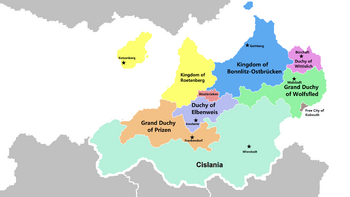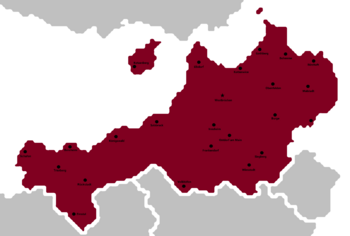Portal:Kylaris/Features: Difference between revisions
No edit summary |
No edit summary |
||
| Line 1: | Line 1: | ||
<div style="float:left;margin:0.5em 0.9em 0.4em 0;">{{Region icon Kylaris}} | <div style="float:left;margin:0.5em 0.9em 0.4em 0;">{{Region icon Kylaris}} | ||
{{multiple image | |||
| align = left | |||
| direction = vertical | |||
| header = | |||
| width = 350 | |||
| image1 = Preunification werania.png | |||
| alt1 = | |||
| caption1 = | |||
| image2 = Werania post WTA.png | |||
| alt2 = | |||
| caption2 = Weranian kingdoms in 1836 (above) and the unified Weranian state in 1856 (below) | |||
The | }} | ||
('''[[ | </div>'''Weranian Unification''', known in [[Werania]] as simply the '''Einigung''', was the process in which the previous divided kingdoms and city-states of the Weranian lands became the modern nation state of the Weranian Confederation which was declared on the 17<sup>th</sup> March 1842. The process is believed to have started with the [[Weranian Revolution of 1828]] although has its roots in the [[Weranian Revolution|1785 revolution]] that had led to the dissolution of the [[Rudolphine Confederation]] and the creation of the [[Weranian Republic]]. | ||
Inspired by a mixture of notions including {{Wp|nationalism}}, {{wp|historical revisionism}}, {{wp|republicanism}}, {{wp|liberalism}}, {{wp|secularism}} and {{wp|democracy}} the impetus for Weranian unification following the republic's dissolution led to the start of the "Weranic Question" of whether a state for the Weranian people should emerge, if it should be a {{Wp|republic}} or {{wp|monarchy}} and if it only consist of {{wp|High German|Weranian}} speaking lands or be enlarged to those who spoke common Weranic languages. During the early 19th century these questions led to an outpouring of nationalist activity in the Weranic states notably through the revolutionary secret society, the [[Septemberists]]. | |||
By 1829 republican nationalists united with monarchists in the Kingdom of [[Cislania]] to jointly promote the cause of unification. Gaining the support of [[Estmere]] these liberal nationalists began to see [[Kirenia]] as the biggest obstacle to unification. From 1836 starting with the [[Septemberist Revolt]] in Bonnlitz-Ostbrücken to the 1841-42 [[Weranian War of Unification]] the pace of unification under the Cislanian banner rapidly increased with the Weranian Confederation being declared following the victory of Cislanian forces in 1842. The state further expanded with the [[Easter Revolution]] in the eastern Weranian states. | |||
The final act of Weranian unification was the [[War of the Triple Alliance]] fought between Werania and [[Estmere]] against Kirenia, [[Gaullica]] and [[Soravia]]. Although the war had intended to unite the rest of the Weranic lands in Kirenia - considered to be the entirely Weranic speaking east marches and partially Weranian speaking Ruttland - into Werania, it failed to do so with Werania acquiring Ruttland alone. However the war did result in the survival of a unified Weranian nation confirming its presence permanently in [[Euclea]]. | |||
Weranian unification is considered to have changed the {{wp|balance of power}} in [[Euclea]]. It represented a decline in Kirenia and [[Solstiana]] whilst the creation of a unified Werania introduced a new {{Wp|great power}} on the continent that would compete with Gaullica, Soravia, Estmere and [[Etruria]] for influence. Weranian unification is still celebrated in Werania despite there still being debate as to whether its primary protagonists - [[Rudolf VI of Werania|Rudolf VI]] and [[Ulrich von Bayrhoffer]] - intended to unify Werania or whether unification was the result of ''ad hoc'' agreements pursued out of pragmatism and opportunism. | |||
('''[[Weranian Unification|read more...]]''') | |||
<div style="text-align:right>[[File:KylarisRecognitionAchievement.png|25px]] '''{{cl|Kylaris Articles of Recognition|See all articles of recognition}}'''</div> | <div style="text-align:right>[[File:KylarisRecognitionAchievement.png|25px]] '''{{cl|Kylaris Articles of Recognition|See all articles of recognition}}'''</div> | ||
Revision as of 10:55, 1 May 2021
Weranian Unification, known in Werania as simply the Einigung, was the process in which the previous divided kingdoms and city-states of the Weranian lands became the modern nation state of the Weranian Confederation which was declared on the 17th March 1842. The process is believed to have started with the Weranian Revolution of 1828 although has its roots in the 1785 revolution that had led to the dissolution of the Rudolphine Confederation and the creation of the Weranian Republic.
Inspired by a mixture of notions including nationalism, historical revisionism, republicanism, liberalism, secularism and democracy the impetus for Weranian unification following the republic's dissolution led to the start of the "Weranic Question" of whether a state for the Weranian people should emerge, if it should be a republic or monarchy and if it only consist of Weranian speaking lands or be enlarged to those who spoke common Weranic languages. During the early 19th century these questions led to an outpouring of nationalist activity in the Weranic states notably through the revolutionary secret society, the Septemberists.
By 1829 republican nationalists united with monarchists in the Kingdom of Cislania to jointly promote the cause of unification. Gaining the support of Estmere these liberal nationalists began to see Kirenia as the biggest obstacle to unification. From 1836 starting with the Septemberist Revolt in Bonnlitz-Ostbrücken to the 1841-42 Weranian War of Unification the pace of unification under the Cislanian banner rapidly increased with the Weranian Confederation being declared following the victory of Cislanian forces in 1842. The state further expanded with the Easter Revolution in the eastern Weranian states.
The final act of Weranian unification was the War of the Triple Alliance fought between Werania and Estmere against Kirenia, Gaullica and Soravia. Although the war had intended to unite the rest of the Weranic lands in Kirenia - considered to be the entirely Weranic speaking east marches and partially Weranian speaking Ruttland - into Werania, it failed to do so with Werania acquiring Ruttland alone. However the war did result in the survival of a unified Weranian nation confirming its presence permanently in Euclea.
Weranian unification is considered to have changed the balance of power in Euclea. It represented a decline in Kirenia and Solstiana whilst the creation of a unified Werania introduced a new great power on the continent that would compete with Gaullica, Soravia, Estmere and Etruria for influence. Weranian unification is still celebrated in Werania despite there still being debate as to whether its primary protagonists - Rudolf VI and Ulrich von Bayrhoffer - intended to unify Werania or whether unification was the result of ad hoc agreements pursued out of pragmatism and opportunism.
(read more...)

